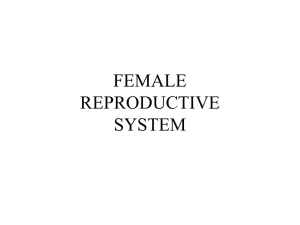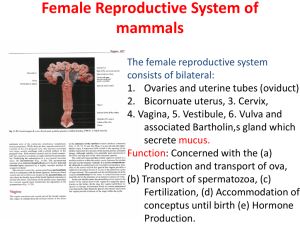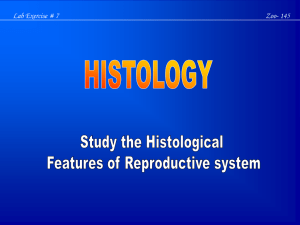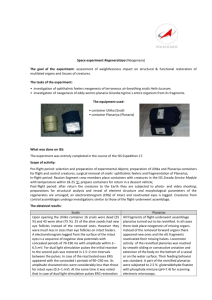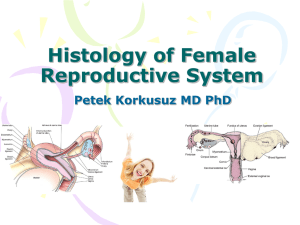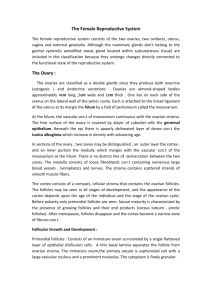Hossam Fouad Attia_Histological and histochemical changes in the
advertisement
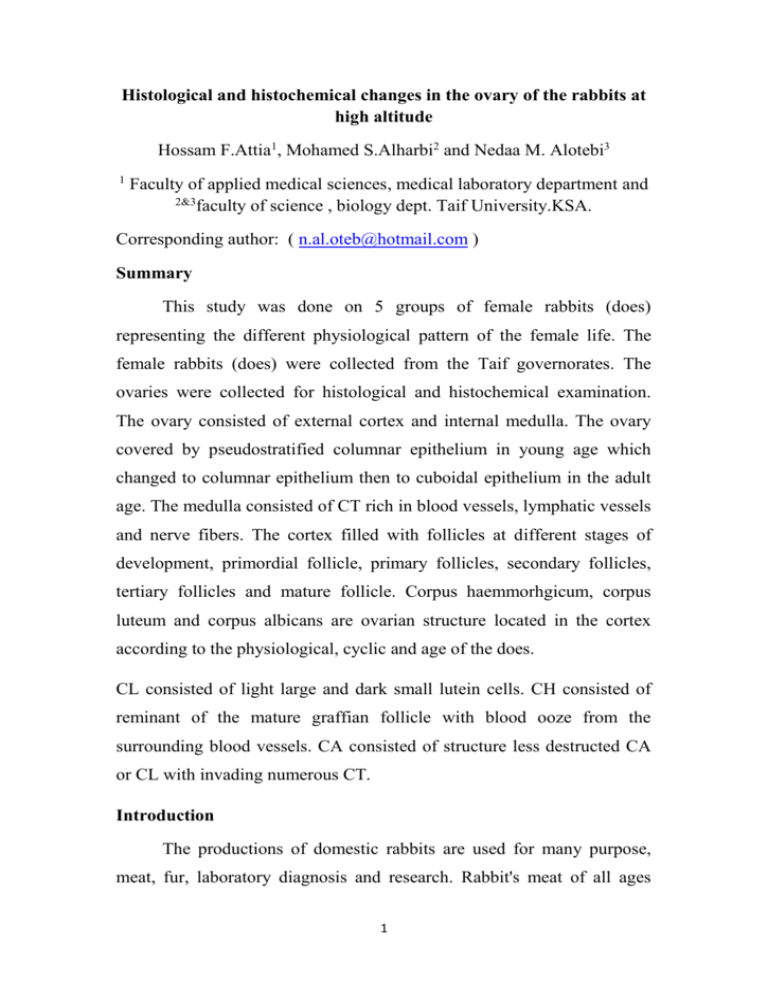
Histological and histochemical changes in the ovary of the rabbits at high altitude Hossam F.Attia1, Mohamed S.Alharbi2 and Nedaa M. Alotebi3 1 Faculty of applied medical sciences, medical laboratory department and 2&3 faculty of science , biology dept. Taif University.KSA. Corresponding author: ( n.al.oteb@hotmail.com ) Summary This study was done on 5 groups of female rabbits (does) representing the different physiological pattern of the female life. The female rabbits (does) were collected from the Taif governorates. The ovaries were collected for histological and histochemical examination. The ovary consisted of external cortex and internal medulla. The ovary covered by pseudostratified columnar epithelium in young age which changed to columnar epithelium then to cuboidal epithelium in the adult age. The medulla consisted of CT rich in blood vessels, lymphatic vessels and nerve fibers. The cortex filled with follicles at different stages of development, primordial follicle, primary follicles, secondary follicles, tertiary follicles and mature follicle. Corpus haemmorhgicum, corpus luteum and corpus albicans are ovarian structure located in the cortex according to the physiological, cyclic and age of the does. CL consisted of light large and dark small lutein cells. CH consisted of reminant of the mature graffian follicle with blood ooze from the surrounding blood vessels. CA consisted of structure less destructed CA or CL with invading numerous CT. Introduction The productions of domestic rabbits are used for many purpose, meat, fur, laboratory diagnosis and research. Rabbit's meat of all ages 1 shows high values for human consumption, it has a higher percentage of protein than other meats and the meat itself is highly digestible, for this reason it is often recommended for sick people (Sandford and Woodgate , 1974 and Zotte, 2002). The health effects of high altitude-induced hypoxia which affect a large number of people live at high altitudes and many others like to visit such areas for trekking, climbing or athletic training. The composition of the air stays the same but the total barometric pressure falls as altitude increases. As a result, the partial pressure of oxygen decreases and a state of hypoxia occurs (Michiels, 2004). Certain biochemical, physiological and microanatomical responses occur during acclimatization and adaptation to chronic hypoxia of high altitude (Ward et al., 1989). Therefore, the adaptive processes that occur in response to hypoxia indicate complex modifications in the homeostatic steady state of endocrine and metabolic functions (Michiels, 2004). The citizen which live in high altitude have the ability to modify their body biochemistry and hormone status (Palinkas et al., 2007). The ovaries are two in each side. It located on the lateral wall of the pelvis. It supported by the broad ligament. The ovary composed of cortex externally and medulla internally. The surfaces of the ovaries covered by simple cuboidal or columnar epithelium above CT fibers thick tunica albuginea. The cortex contain interstitial CT. The cortex parenchyma consists of primordial, primary, secondary, tertiary follicles, mature follicles, corpus luteum and atretic follicles. The medulla consists of loose connective tissue rich in blood and lymph vessels. The ovary functions as an organ of reproduction and also as a gland of internal secretion.. It secrete the mature graffian follicles (Exocrine 2 function) and non-steroidal hormones that act locally (Endocrine function) (Hodges et al.,1985). Over the portions of the ovary covered by low columnar or cuboidal epithelium, cells frequently appeared to be detaching from the surface. Tunica albuginea, a poorly vascularized, dense, irregular collagenous connective tissue capsule. Each ovary was subdivided into the highly cellular cortex and medulla, which consisted mostly of a richly vascularized loose connective tissue. The cortex, which was surrounded on the outside by the surface epithelium, contained germ cell clusters, some primordial, primary, secondary, tertiary and atretic follicles, and dilated blood vessels (Bjersing et al,1981 and Ozdemir et al., 2005). Bruin et al.,2002, reported that the primordial follicles located under tunica albuginea and extended deeply for a short distance into the cortical tissue. The primordial follicle consists of a primary oocyte surrounded by a single layer of flattened follicular cells which are cuboidal in shape. Primary follicles consists of a primary oocyte surrounded by a simple cuboidal or columnar follicular cells.. Secondary follicles consists of a primary oocyte surrounded by a stratified epithelium of granulosa cells. Tertiary follicles were composed of a primary oocyte surrounded by a stratified epithelium of follicular cumulus cells. The stratum granulosum was surrounded by the theca, which in tertiary follicles differentiates into two layers: an inner vascular theca interna and an outer supportive theca externa. The theca interna cells were spindle-shaped and located in a delicate reticular fiber. The theca externa consisted of a thin layer of loose connective tissue with fibroblasts arranged concentrically around the theca interna. The zona pellucida is structureless layer which surround the oocyte. It is glycoprotein in nature and has fundamental role in during 3 fertilization and early development (Dunbar et al., 1981; Sacco et al., 1981; Hedrick and Wardrip, 1987; Yurewicz et al., 1987 and Wassarman, 1988), such as species-specific attachment and binding of spermatozoa (O'Rand, 1988), induction of the acrosome reaction (Bleil and Wassarman, 1983 and Cherr et al., 1986) and the block to polyspermy (Braden et al., 1954). Zona pellucida is a potent heteroimmunogen and share common antigenic determinants . Zona antisera possess contraceptive activity in vitro and in vivo (Sacco, 1981; Dunbar, 1983; Maresh and Dunbar, 1987and Henderson et al., 1988). Human and porcine zona share common antigens (Sacco, 1977 and Koyama et al., 1985) and antiserum to porcine zona demonstrates contraceptive efficacy in humans (Trounsonet al., 1980 and Henderson et al, 1987a). In the ovary of unmated or un-stimulated rabbits, therefore, functional corpora lutea (CL) should not be present and, in circulating plasma, progesterone concentration should remain at basal level. (Boiti et al., 1996). Materials and Methods The does were collected from Taif governorates and divided into 5 groups represented the ages and physiological state. At I month ( young), 5 months ( immature ) , 8 month (adult pregnant) , 12 months ( adult lactating ) and 24 months ( senile ). The ovaries were removed from rabbits under ether anesthesia preserved in 10% formalin, bouin's solution, dehydrated, cleared in xylol and cut at 5micron . These techniques were done according to (Bancroft et al.,1994). 4 Results The ovary of the young doe consisted of cortex and medulla. The cortex located in the outer part while the medulla located in the center of the ovary. The ovary lined by pseudo stratified columnar epithelium (Fig.1). The cortex consisted of numerous primordia cells surrounded by mesenchymal cells, it mainly represented the bulk of the cortex (Fig. 2). Fine collagen fibers extended between the cortical follicles (Fig. 3). Primary follicles were located at the edge of the cortex. The medulla consisted of CT rich in blood vessels, nerves and lymphatic in the center of the ovary (Fig. 4). The medulla, epithelium lining of the ovary and the granulosa cells were strong PAS positive reaction (Fig. 5), while the CT fibers between the follicle was faint PAS positive (Fig. 6). The ovary of the immature doe covered by pseudo stratified columnar epithelium. The tunica albuginea located beneath the covering epithelium, it consisted of thick layer of CT (Fig.7). The secondary follicles were appeared and they consisted of ovum in the center surround by eosinophilic yolk material and surrounded by shiny eosinophilic structure (zona pellucida). One row of low columnar cells surrounds the zona pellucid that represented the (corona radiata), it characterized by acidophilic cytoplasm and basely situated basophilic nuclei . Small, round cells with centrally located basophilic nuclei surround the corona radiata that represented (granulosa cells) .Fine fibers appeared and surround the follicle in circumference manner might represent the primordia of the theca externa cells (Fig. 8). The tertiary follicles were appeared and characterized by well organized corona radiata cells and increased number of granulosa cells, increased number of theca cells and the theca cells were organized to differentiated into theca interna and theca externa. The antral cavity appeared and filled with antral fluid (Fig. 9). The antral 5 cavities were appeared numerous and large in size, while the granulosa cells increased and fill the spaces between the antral cavities (Fig. 10). The zona pellucida was strong PAS positive reaction while the theca and the CT between the follicles were faint PAS reaction (Fig. 11). Some follicles showed atresia and surrounded by numerous CT with disruption and desquamation in the granulosa cells (Fig. 12). The epithelium lining of the ovary became high cuboidal epithelium. The mature follicles appear at the late stage of the immature age. It characterized by well organized, granulosa cells, theca cells and appearance of cumulus oophurus, which hanged up the oocyte inside the antral cavity. The mature follicle characterized by positive PAS reaction in the oocyte, granulosa and theca cells (Fig. 13). The ovary of the pregnant doe showed increased in size. The covering epithelium lining decreased in size to be simple cuboidal epithelium rest on thick tunica albuginea. The medulla characterized by well developed blood vessels (Fig.14). The corpus haemorraghicum was formed after ovulation. It consisted of rest cells of the mature graffian follicle except oocyte which emerge from the stigma in the wall of the graffian follicle. Some granulosa cells showed disruption (Fig. 15). The blood oozes from the blood vasculature and fill the antral cavity of the corpus haemmorhgicum (Fig. 16). After fertilization the corpus luteum ( CL) was formed. It formed from the cells of the granulosa and theca cells. It persisted during the period of pregnancy. It separated from the neighboring follicles by CT fibers (Fig. 17). The CL consisted of small and large lutein cells. The large lutein cells appeared pyramidal or oval in shape, large in size with faint basophilic cytoplasm and large basophilic nuclei while the small lutein cells appeared small ovoid cells with dark basophilic cytoplasm ( Fig. 18). The CL characterized well organized to 6 light large lutein cells in the middle of the CL while the dark small lutein cells located in the periphery of the CL (Fig. 19). Strong PAS reaction in the tunica albuginea ovarian epithelium, CT fibers, zona pellucid and theca cells (Fig. 20), while faint PAS reaction in the granulosa cells. No metachromatic reaction was detected in the ovary (Fig. 21). The lining epithelium of the ovary of lactating doe was cuboidal in shape rest on thick tunica albuginea (Fig.22). The blood vessels of the medulla showed thick wall and the CT fibers between the cortical follicle was increased .The tunica albuginea and the covering epithelium of the ovary was PAS positive while faint reaction in the CT of the cortex (Fig.23). Some follicles filled with 9-10 oocytes inside one follicle. It characterized by thick theca cells (Fig. 24). The cortex filled with numerous atretic follicles between the other developing follicles (Fig.25). The lutein cells, large and small showed vacuolation and sparsely desquamation in the cytoplasm with eccentric pyknotic nuclei (Fig.26). The reminants of the CL escape to the surface of the ovary and invaded by CT cells and fibers (Fig.27). The ovary of the senile doe showed increase in the thickness of the tunica albuginea with increased CT fibers between the cortical follicles. Some cells of the covering epithelium showed desquamation (Fig.28). Numerous follicles showed disruption and atretic characters (Fig.29). The cytoplasm of the primordial cells showed sparsely degranulation and the nuclei showed pyknosis (Fig.30). Some follicles showed atresia with lymphocytic infiltration (Fig.31 and32). The other follicles showed normal pattern of development. The medulla blood vessels showed congestion (Fig.33). Numerous lymphocytic infiltrations occupy most of the medulla architecture. The corpus albicans located in the periphery of the ovary cortex under the tunica albuginea. It consisted of numerous CT 7 that replaced the follicular cells. It was positive PAS reaction (Fig.34). All the atretic follicles, covering epithelium and tunica albuginea were positive PAS reaction (Fig.35 ). Discussion The ovary of the rabbit was consisted of cortex externally and medulla internally. It covered by pseudostratified columnar epithelium in the young age and became cuboidal epithelium in the mature ages. The cortex surrounded by tunica albuginea which consisted of CT. The ovary had the same oriental structure in all rabbit species and other animals except mares. This finding was supported by the result of (Bjersing et al., 1981; Junqueira, and Carneiro,2003 and Ozdemir et al., 2005). In contrast to this finding (Ozdemir and Dinc, 2002 and 2003) reported that the surface epithelium was simple cuboidal in young animals and simple squamous in older animals. The changes in the epithelial shape in the covering epithelium from pseudostratified to cuboidal epithelium in the young and adult age due to cyclic changes and mitotic divisions during estrous cycle. This result was supported by the findings of (Ozdemir and Dinc, 2002 and 2003) in guinea pig and (Weakley, 1969) in hamster. The medulla consisted of highly vascularized CT rich in blood vessels, lymph vessels and nerve fibers. This finding was in agreement with (Numazawa and Kawashima, 1982) in mouse , (Ozdemir and Dinc, 2002), in guinea pig and (Hafez, 1970 and Dellmann and Brown, 1981) in domestic animals. The cortexes contain different follicles at different stages of development. Primary, secondary, tertiary and mature graffian follicles. Corpus luteum 8 , corpus albicans and corpus haemmorrhgicum were prominent in the cortex. Numerous polyovular follicles were demonstrated in the cortex of the lactating does. Similar findings were evident in many animals as the ovaries of some rodents and hamster (Bodemer et al., 1959; Bodemer and Warnick, 1961 and Weakley, 1969), guinea pig (Collins and Kent, 1964). In contrast to these results no polyovular follicles not detected in guinea pig (Ozdemir and Dinc 2002), and (Odor and Blandau 1968). The oocytes surrounded by follicular cells, these cells appeared cuboidal or columnar in shape (corona radiata layer and granulosa cell layers ). Zona pellucida was PAS positive materials. Similar findings have also been observed in rat ( Sotelo and Porter,1959), in mouse (Odor and Blandau, 1968) and guinea pig (Ozdemir and Dinc, 2002). The primordial follicles represented about a third of the follicles. While the majority of the follicles represented by the developing follicles up to the mature one. The sizes of oocytes, oocyte nuclei, and their ratios did not change with follicle stage up to the primary stage. Most of the follicles in the does rabbits were in the intermediary stages as that of the bovine ovaries, more than 80% of follicles were found to be at the intermediary or primary stage (Van Wezel and Rodgers, 1996). The corpus luteum was formed after induced ovulation in does. It consisted of small and large lutein cells. The large cells were located externally, large in size with granular cytoplasm, while the small ones were located internally, small in size with small nucleus. These cells originated from theca and granulosa cells as that reported by (Buffet and Bouchard, 2001). The corpus luteum has a principal role in production of steroidal hormones, including estradiol, progesterone and androgen (Buffet and Bouchard, 2001). 9 The corpus luteum give progesterone hormone which is responsible for calming of the uterus during pregnancy and maintenance of embryos during pregnancy and differentiation between fertile and infertile cycles ( Niswender et al.,2000). The steroidogenic cells in the luteum body are denominated large lutein cells (LLC) and small lutein cells (SLC), which can be distinguished by their size and other functional and structural characteristics (Alila and Hansel, 1984 and Fields and Fields, 1996). Many atretic follicles were reported in the contour of the rabbit cortex. These follicles were strong PAS positive reactions. The atretic follicles represented different failed follicles to reach maturity (O’shea, 1970). Signs of atresia remained obscure, similar findings of a low rate of atresia have been reported (Himelstein-Braw et al.,1976). Apparently, resting follicles accumulate little damage, which may be associated with their low metabolic rate (Okatay et al.,1997). The increase in atresia may occur only after the initiation of rapid follicle growth. The granulosa cells surround the oocyte and the antrum cavities. It was polyhedral to polygonal in shape with centrally located basophilic nuclei and acidophilic cytoplasm. Similar results were stated by (Nottola et al., 2006). While (Dhar et al., 1996; Gersak and Tomazevic, 1999 and Whitman et al., 1989), identified different granulosa cell subpopulations, corresponding to different stages of luteal differentiation References Alila, W. and Hansel, W. (1984). Origin of different cell types in the bovine corpus luteum as characterized by specific monoclonal antibodies. Biol. Reprod., v.31, p.1015-1025. Bancroft, J.D., H.C. Cook, R.W. Stirling and D.R. Turner, (1994). Manual of Histological Techniques and their Diagnostic 10 Application. 2nd Edn., Churchill Livingstone, Edinburgh, London, New York, Pages: 192. Bjersing, L., Cajander, S., Damber, J. E., Janson, P. 0. and Kallfelt, B. (1981). Ths isolated perfused rabbit ovary-a model for studies of ovarian function. Ultrastructure after perfusion with different media. Cell. Tissue. Res. 216:471-479. Bleil, J.D. and Wassarman, P.M. (1983). Sperm-egg interactions in the mouse: sequence of events and induction of the acrosome reaction by a zona pellucid glycoprotein. Developmental Biology 95, 317324. Bodemer, C. W., R. E. Rumery and R. J. Blandau (1959).Studies on induced ovulation in the intact immature hamster. Fertil. Steril. 10, 350-360. Bodemer, C. W. and S. Warnick (1961).Polyovular follicles in the immature hamster ovary. Fertil. Steril. 12, 159-169. Boiti C., Besenfelder U., Brecchia G., Theau-Clèment M. and Zerani M. (2006). Reproductive physiopathology of the rabbit doe. In: L. Maertens and P. Coudert (Eds.). Recent advances in rabbit Science, COST Action 848, 3-20. Boiti C., Canali C., Monaci M., Stradaioli G., Verini Supplizi A., Vacca C., Castellini C., and Facchin E. (1996). Effect of postpartum progesterone levels on receptivity, ovarian response, embryo quality and development in rabbits. In: Proc. 6th World Rabbit Congress, June 1996, Toulouse, France, Vol. 2, 45-49. Boroujeni M. Beigi , Nasim Beigi Boroujeni, Mojdeh Salehnia, Elahe Marandi and Masoud Beigi Boroujeni. (2012). Ultrastructural Changes of Corpus Luteum after Ovarian Stimulation at Implantation Period. Iranian Biomedical Journal 16 (1): 33-37 . Boue, S. M. (2003). Evaluation of the estrogenic effects of legume extracts containing phytoestrogens. Journal of Agricultural and Food Chemistry, 2, 148-150. Cherr, G.N., Lambert, H., Meizel, S. and Katz, D.F. (1986). In-vitro studies of the golden hamster sperm acrosome reaction: completion on the zona pellucida and induction by homologous soluble zonae pellucidae. Developmental Biology 114, 119-131. 11 Collins, D. C., and H. A. Kent (1964). Polynuclear ova and polyovular follicles in the ovaries of young guinea pigs. Anat. Rec. 148, 115-119. Delmann, H. D. and E. M. Brown (1981). Textbook of Veterinary Histology. 2nd ed. Lea and Febiger. Philadelphia, pp. 233-245. Dhar, A., Dockery, P., and O, W.S., et al., (1996). The human ovarian granulosa cell: a stereological approach. J. Anat. 188, 671–676. Dunbar, B.S. (1983). Antibodies to zona pellucid antigens and their role in fertility. In Immunology of Reproduction, pp. 507-534. Eds T. G. Wegmann, T. J. Gill & C. D. Cumming. Oxford University Press, New York. Dunbar, B.S., Liu, C. and Sammons, D.W. (1981) .Identification of the three major proteins of porcine and rabbit zonae pellucidae by high resolution two-dimensional gel electrophoresis: comparison with serum, follicular fluid and ovarian cell proteins. Biology of Reproduction 24, 1111-1124. Fields, M.J. and Fields, P.A. (1996). Morphological characteristics of the bovine corpus luteum during the estrus cycle and pregnancy. Theriogenology, v.45, p.1295-1325. Gersak, K., and Tomazevic, T., (1999). Subpopulations of human granulosa-luteal cells obtained from gonadotrophin- or gonadotrophin- releasing hormone agonist/gonadotrophin-treated follicles in vitro fertilization–embryo transfer cycles. J. Assist.Reprod. Genet. 16, 488–491. Hafez, E. S. E. (1970).Reproduction and breeding techniques for laboratory mammals. Lea and Febiger, Philadelphia. Printed in U.S.A., pp. 246-256. Hedrick, J.L. and Wardrip, N.J. (1987) .On the macromolecular composition of the zona pellucida from porcine oocytes. Developmental Biology 121,478-488. Henderson, C.J., Braude, P. and Aitken, R.J. (1987a). Polyclonal antibodies to a 32-kDa deglycosylated polypeptide from porcine zonae pellucidae will prevent human gamete interaction in vitro. Gamete Research 18, 251-265. Henderson, C.J., Huhne, M.J. and Aitken, R.J. (1988). Contraceptive potential of antibodies to the zona pellucida. Journal of Reproduction and Fertility 83, 325-343. 12 Himelstein-Braw R, Byskov AG, Peters H, and Faber M. (1976). Follicular atresia in the infant human ovary. J Reprod Fertil; 46:55– 59. Hodges JK, Harlow CR, and Hillier SG (1985). Follicular function in the marmoset ovary. Ann Conf Soc for the Study of Fertility, Aberdeen. (Abstract46). Koyama, K., Hasegawa, ., Tsuji, Y. and Isojima, S. (1985). Production and characterization of monoclonal antibodies to cross-reactive antigens of human and porcine zonae pellucidae. Journal of Reproductive Immunology!, 187-198. Maresh, G.A. and Dunbar, B.S. (1987). Antigenic comparison of five species of mammalian zonae pellucidae. Journal of Experimental Zoology 244, 299-307 Michiels, C., (2004). Physiological and pathological responses to hypoxia. Am. J. Pathol., 164: 1875-1882. PMID: 15161623. Niswender G.D, Juengel J.L, Silva P.J, Rollyson M.K, and Mclntush E.W. (2000). Mechanisms controlling the function and life span of the corpus luteum. Physiol Rev. Jan;80(1):1-29. Nottola, S.A., Heyn, R., and Camboni, A., et al., (2006). Ultrastructural characteristics of human granulosa cells in a coculture system for in vitro fertilization. Microsc. Res. Tech. 69, 508–516. O’shea, J. D. (1970). An ultrastructural study of smooth muscle-like cells in the theca externa of ovarian follicles in the rat. Anat. Rec.167, 127-140. Odor, D. L., and R. J. Blandau (1968). Ultrastructural studies on fetal and early postnatal mouse ovaries. I. Histogenesis and oogenesis. Am. J. Anat. 124, 163-186. Oktay K, Nugent D, Newton H, Salha O, Chatterjee P, and Gosden RG. (1997). Isolation and characterization of primordial follicles from fresh and cryopreserved human ovarian tissue. Fertil Steril; 67:481–486. Olsen N.V, Hansen J.M, Kanstrup I.L, Richalet J.P, and Leyssac P.P. (1993). Renal hemodynamics, tubular function, and response to lowdose dopamine during acute hypoxia in humans. J Appl Physiol 74: 2166–2173. O'Rand. M.G. (1988). Sperm-egg recognition and barriers to interspecies fertilization. Gamete Research 19,315-328. 13 Ozdemir, D., A. Aydin, S. Yilmaz, G. Dinc, and O. Atalar (2005). Observations on the morphology of the ovaries of the porcupine (Hystrix cristata). VETERINARSKI ARHIV 75 (2), 129-135. Ozdemir, D., and G. Dinc. (2002). Kobaylarda ovaryumlarin postnatal gelisimi uzerinde isik mikroskobik incelemeler. F.U. Saglik Bil. Derg. 16,169-174. Ozdemir, D., and G. Dinc (2003). Postnatal donemde kobay ovaryumlari uzerinde elektron mikroskobik bir calisma. F.U. Saglik Bil. Derg. 17, 17-22 Palinkas L.A, Reedy K.R, Shepanek M, Smith M, Anghel M, and Steel G.D et al. (2007). Environmental influences on hypothalamic– pituitary–thyroid function and behavior in Antarctica. Physiol Behav; 92(5):790–9. Sacco, A.G. (1977). Antigenic cross-reactivity between human and pig zona pellucida. Biology of Reproduction 16, 164-173. Sacco, A.G. (1981). Immunocontraception: consideration of the zona pellucida as a target antigen. In Obstetrics and Gynecology Annual Vol. 10, pp. 1-26. Ed. R. M. Sacco, A.G., Yurewicz, E.C, Subramanian, M.G. and DeMayo, F.J. (1981). Zona pellucida composition: species cross-reactivity and contraceptive potential of antiserum to a purified pig zona antigen (PPZA). Biology of Reproduction 25, 997-1008. Sanford, J. C., and Woodgate, F. G. (1974). The domestic rabbit grenade Publishing Ltd. New York. Sotelo, J. R., and Porter, K. R. (1959). J. Biophysic. And Biochem. Cytol., 5, 327. Van Wezel I, and Rodgers R.J. (1996). Morphological characterization of bovine primordial follicles in their environment in vivo. Biol Reprod; 55:1003–1011. Ward, P.W., J.S. Millege and J.B. West, (1989). Altitude and Haemoglobin Concentration. In: High Altitude Medicine and Physiology, Ward, P.W., J.S. Millege and J.B. West (Eds.). Chapman and Hall, London, pp: 170-171. Wassarman, P. M. (1988). Zona pellucida glycoproteins. Annual Reviews of Biochemistry 57, 415-442. 14 Weakley, B. S. (1969). Differentiation of the surface epithelium of the hamster ovary. An electron microscopic study. J. Anat. 105, 129147. Whitman, G.F., Luciano, A.A., and Maier, D.B., et al., (1989). Human chorionic gonadotrophin localization and morphometric characterization of human granulosa-luteal cells obtained during in vitro fertilization cycles. Fertil. Steril. 51, 475–479. Yurewicz, E.C, Sacco, A.G. and Subramanian, M.G. (1987). Structural characterization of the M, = 55 000 antigen (ZP3) of porcine oocyte zona pellucida. Journal of Biological Chemistry 262, 564-571. Zotte, D.A. (2002) .Perception of rabbit meat quality and major factors influencingnthe rabbit carcass and meat quality. Livestock Production Science 75 ,11 –32. 15 List of Figures Plate.1: photomicrograph of the young rabbit’s ovary showing; in fig.1, the ovary consisted of outer cortex ( C ) and inner medulla (M), the covering epithelium is pseudostratified columnar epithelium (P) . H&E.X10. In.2, numerous primordial follicles surrounded by mesenchymal cells ( arrow). H&E X40. In 3, fine collagen fibers extended between the cortical follicles ( arrow) . Crossmon’s trichrome X10. In 4, primary follicles were located at the edge of the cortex ( o ). The medulla consisted of CT rich in blood vessels, nerves and lymphatic ( arrow). Crossmon’s trichrome. X10. In 5, the medulla, epithelium lining of the ovary and the granulosa cells were strong PAS positive reaction ( arrow).PAS.X10.In 6, the CT fibers between the follicle was faint PAS positive ( arrow ).PAS.X40. Plate.2: photomicrograph of the immature rabbit’s ovary showing; in fig.7, the tunica albuginea (arrow) which consisted thick layer of CT. H&E.X10. In.8, in secondary follicle , zona pellucida ( z), corona radiata ( c) , granulosa cells ( g) and theca externa primordia ( arrow). H&E X40. In 9, the tertiary follicles characterized by well organized corona radiata (c) and increased number of granulosa cells (g). The antral cavity appeared and filled with antral fluid ( f) . H&E X10. In 10, the antral cavities were appeared numerous and large in size ( f), while the granulosa ( g) cells increased and fill the spaces between the antral cavities Crossmon’s trichrome. X10. In 11, the zona pellucida was strong PAS positive reaction ( zp ) while the theca and the CT between the follicles were faint PAS reaction ( arrow).PAS.X40.In 12, no metachromatic granules were detected. Toulidine blue X40. In 13, some follicles showed atresia and surrounded by numerous CT with disruption and desquamation in the granulosa cells (arrow). Crossmon’s 16 trichrome.X40.In 14, mature follicle characterized by positive PAS reaction in the oocyte, granulosa and theca cells ( arrow ).PAS.X40. Plate.3&4: photomicrograph of the pregnant rabbit’s ovary showing; in fig.15, well developed blood vessels in the ovary medulla ( arrow). Crossmon’s trichrome.X10. In.16, the rest of the mature follicle forming the CH ( arrow). H&E X40. In 17, fully developed CH ( ch) . H&E X40. In 18, the CL separated from the ovarian structure by CT ( arrow) . H&E X10. In 19, The CL consisted of small and large lutein cells ( CL) . In 20 , the large lutein ( L) cells appeared pyramidal or oval in shape, large in size with faint basophilic cytoplasm and large basophilic nuclei while the small lutein ( S) cells appeared small ovoid cells with dark basophilic cytoplasm. H&E X40. In 21, mature follicle characterized by positive PAS reaction in the oocyte, granulosa and theca cells ( arrow ).PAS.X40. In,22, no metachromatic granules were detected in the ovary.TB.X40. Plate.5: photomicrograph of the lactating rabbit’s ovary showing; in fig.23, thick tunica albuginea( arrow) and thick blood vessels in medulla (bv). Crossmon’s trichrome.X10. In.24, the epithelium was positive PAS ( arrow) while the CT was faint reaction (f). PAS X40. In 25, some follicles contains numerous oocytes ( o) with thick theca cells ( arrow) . H&E X40. In 26, numerous atretic follicles between the other follicles (arrows). H&E X10. In 27, The CL showed vacuolation ( v) and sparsely desquamation ( d ) in the cytoplasm with eccentric pyknotic nuclei .Masson trichrome.X40.In 28, CT fibers invade the CL (arrow). H&E.X40. 17 Plate.6: photomicrograph of the senile rabbit’s ovary showing; in fig.29, thick tunica albuginea( arrow) and desquamated some cells of the covering epithelium (d). H&E.X10. In.30, atretic follicles between the other follicles (arrows) . H&E X40. In 31, the cytoplasm of the primordial cells showed sparsely degranulation ( sd) and the nuclei showed pyknosis. H&E X40. In 32, Some follicles showed lymphocytic infiltration (L). H&E X40. In 33, Some follicles showed atresia ( arrows) .H&E.X40.In 34, medullary blood vessels showed congestion (arrows). H&E.X40. 35, positive PAS reaction in the atretic follicles (arrows). PAS.X40. 36, positive PAS reaction in the covering epithelium atretic follicles (arrows). PAS.X10. 18 19 20 21 22 23 24
